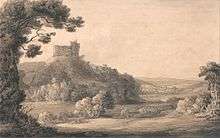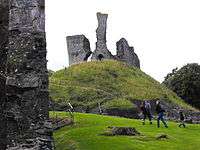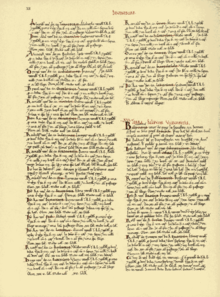Feudal barony of Okehampton


The feudal barony of Okehampton was a very large feudal barony, the largest mediaeval fiefdom in the county of Devon, England,[1] whose caput was Okehampton Castle and manor. It was one of eight feudal baronies in Devonshire which existed during the mediaeval era.[2]
Descent

The first holder of the feudal barony of Okehampton was Baldwin FitzGilbert (died 1090) called in the Latin Domesday Book of 1086 Baldvinus Vicecomes, "Baldwin the Vice-Count" (of the County of Devon), which office equated to the earlier Saxon office of Sheriff of Devon. The Norman office of Viscount soon was replaced by that of Sheriff, thus Baldwin is known in modern times as "Baldwin the Sheriff", but also has several other aliases, such as "Baldwin de Moels", (or "Meules", "Moeles", etc.) "Baldwin FitzGilbert" and "Baldwin de Brionne". He was the younger son of Gilbert, Count of Brionne, and took his name "de Moels" from the manor of Meulles in Calvados, Normandy.[1] His fiefdom listed in Domesday Book comprised 176 land-holdings, mostly manors, but 2 of which, listed first, comprised groups of houses in Barnstaple and Exeter. The third holding listed for his fiefdom is Okehampton: Ipse Balduin ten(et) de rege Ochementone, ibi sedet castellum ("Baldwin himself (i.e. in demesne) holds Okehampton from the king, there sits his castle"). The nature of the feudal land tenure for feudal barons was per baroniam, that is to say they were bound to serve the king as one of his barons, which involved onerous duties not only of attending parliaments to advise the king but also of providing knights and soldiers for military service to the royal army for specified periods each year. The baron himself was frequently present in battle.
De Moels
The descent in the de Moels family was as follows:[3]
- Baldwin de Moels (died 1090), who married a certain Emma. All three of his sons died successively without children, and were succeeded by the children of their two sisters, about which surviving sources are obscure. However, his brother, Richard FitzGilbert de Bienfaite, Lord of Clare, had issue, one of whom was Walter de Clare, the founder of Tintern Abbey in Wales. [4]
- William FitzBaldwin (died 1096)(son), died without children
- Robert FitzBaldwin (died 1101) (brother), died without children
- Richard FitzBaldwin (died 1137) (brother), Sheriff of Devon in 1096, died without children. He founded Brightley Abbey[5]
- Robert d'Avranches (nephew), son of Emma FitzBaldwin, according to Pole (died 1135), the younger of Baldwin's two daughters,[6] the elder being Adela FitzBaldwin (died 1142)[7] According to Pole Adela married "a Kentish knight", but according to The Complete Peerage she was the amita of Ranulf Avenel, however both sources agree that she died childless. Emma however married as her second husband William d'Avranches (d. circa 1087), (her first husband having been Ranulf (or William[8]) Avenel (died 1128/9)), by whom she had a son Robert d'Avranches, who according to Pole was "loved"[8] by his uncle Richard FitzBaldwin (died 1137), feudal baron. Richard effectively handed over the barony to his nephew Robert d'Avranches by making all his tenants give homage and swear fealty to Robert in place of himself and as his heir.[8] Robert d'Avranches left England, never to return, and married the daughter of Godwin (or "Gelduin"[3]) de Dol, by whom he had a daughter and sole-heiress Maud (or Matilda) d'Avranches (died 1173).
- Adela FitzBaldwin (died 1142), (aunt), the elder daughter of Baldwin, succeeded[8] to the barony following the successive deaths of Richard FitzBaldwin (died 1137) and Robert d'Avranches. As she was childless, she appointed as her heir Ralph Avenel, her sister Emma's eldest son.
- Ralph Avenel (nephew), eldest son of Emma FitzBaldwin by her first marriage to William (or Ralph[3]) Avenell. His great inheritance prompted Reginald de Dunstanville, 1st Earl of Cornwall (1110–1175), the uncle of King Henry II (1154–1189), to offer him one of his daughters in marriage. Ralph turned down the proffered wife and married instead Matilda de Redvers, sister of Richard de Redvers, Earl of Devon. This angered the Earl of Cornwall, who swore to deprive Ralph Avenell of the barony of Okehampton. This he did by bringing an assize to question the validity of Ralph's tenure, which court ruled that on Robert d'Avranches having taken the homage and fealty of the tenants of the barony, at his uncle's wish, he had thereby become the legal holder of the barony. Thus the true heir, according to the decision of the assize, was his daughter and sole heiress Maud d'Avranches (died 1173). Thus Ralph Avenell was deprived of the barony of Okehampton.[9]
- Maud d'Avranches (died 1173) (cousin), daughter and sole-heiress of Robert d'Avranches. She married firstly William de Curcy (died pre 1162), called by Pole "Lord of Ayncourt", by whom she had a daughter and sole-heiress Hawise de Curcy (died 1219), the heiress of the barony of Okehampton. On the suggestion of Reginald, Earl of Cornwall, the widowed Maud d'Avranches was given secondly in marriage by King Henry II (whose royal licence, and thus effective control, a female tenant-in-chief (or widow of a tenant-in-chief) needed in order to remarry) to the Earl of Cornwall's brother Robert FitzRoy (died 1172) (alias Robert FitzEdith and Robert de Caen), the king's uncle and a natural son of King Henry I of England. By her second husband Maud had a further daughter, Maud, Dame du Sap (died 1224). Maud du Sap, following her father's death, became a royal ward, and King Henry II married her off to Reginald I de Courtenay(died 1190), of the French House of Courtenay, a knight whom King Henry's wife, Eleanor of Aquitaine, had brought to England from France. No children resulted.
- Hawise de Curcy (died 1219)(daughter by 1st marriage), half-sister to Maud, Dame du Sap, second wife of Reginald de Courtenay, whose son and heir by his first wife was Renaud de Courtenay (called by Pole "William"[10]), who "by the advice and command of his father",[10] married Hawise de Curcy, his father's half sister-in-law and heiress to the feudal barony of Okehampton. Thus, the barony came into the possession of the Courtenay family. Reginald's French possessions were confiscated by the French King Louis VII, but were given, together with the marriage of his daughter, Elizabeth de Courtenay, to the King's youngest brother, Peter, who adopted the name Peter de Courtenay. Thus, the Courtenay family thenceforth became dependent on its English lands and became Anglicized.
Courtenay
- Robert de Courtenay (died 1242), son of Reginald de Courtenay (died 1194) by his wife Hawise de Curcy (died 1219), heiress of Okehampton. He married Mary de Vernon, daughter of William de Redvers, 5th Earl of Devon (died 1217), feudal baron of Plympton, Devon. From this marriage the Courtenays later inherited the barony of Plympton in 1293 and in 1335 were declared Earls of Devon.[11]
- John de Courtenay (died 1274),[12] (son) who married Isabel de Vere, daughter of Hugh de Vere, 4th Earl of Oxford (c. 1210 – 1263)
- Sir Hugh de Courtenay (died 1292),[12] (son) who married Eleanor le Despenser (died 1328), daughter of Hugh le Despenser, 1st Earl of Winchester (1261–1326).
- Hugh Courtenay, 9th Earl of Devon (1276–1340),[12] (son). In 1293 on the death of his cousin Isabella de Forz, Countess of Devon (1237–1293) (eldest daughter of Baldwin de Redvers, 6th Earl of Devon (1217–1245), feudal baron of Plympton in Devon[13]) he became heir to the feudal barony of Plympton,[13] and in 1335 was declared Earl of Devon. The descent of the feudal barony of Okehampton thenceforth follows the descent of the earldom of Devon.[14] In 1539 King Henry VIII seized the lands of the barony and had Henry Courtenay, 1st Marquess of Exeter(died 1539) executed for treason.[15] The Earldom of Devon became forfeit, and the Courtenay lands in Cornwall escheated (i.e. reverted) to the crown to be held by the Duchy of Cornwall.
List of constituent manors
The barony comprised originally the following manors held in-chief per baroniam by Baldwin the Sheriff, in order of Domesday Book listing:[16]
| No. | Name of manor | Hundred | Baldwin's tenant | Pre-1066 tenant |
|---|---|---|---|---|
| 1 | 19 houses in Exeter | Hundred | Unknown | Lordship of King Edward the Confessor |
| 2 | 6 destroyed houses in Barnstaple | Hundred | Unknown | Unknown |
| 3 | Okehampton | Lifton | in demesne | Osferth |
| 4 | Chichacott | Lifton | Roger | Brictmer |
| 5 | Bratton Clovelly | Lifton | in demesne | Brictric |
| 6 | Boasley | Lifton | Rolf | Brictric |
| 7 | Bridestowe | Lifton | Ralpf de Pomeroy | Edmer |
| 8 | Germansweek | Lifton | Rainer | Ednoth |
| 9 | Lewtrenchard | Lifton | Roger de Meulles | Brictric |
| 10 | Warson | Lifton | Roger of Meulles | Waddell |
| 11 | Kelly | Lifton | Modbert | Osferth |
| 12 | Dunterton | Lifton | Ralph de Bruyère | Brictmer |
| 13 | Guscott | Lifton | Colwin | Brictric |
| 14 | Sampford Courtenay | Torrington | in demesne | Norman |
| 15 | Belstone | Torrington | Richard | Osferth |
| 16 | Dunsland | Torrington | Cadio | Wulfric |
| 17 | Monkokehampton | Torrington | Baldwin's tenant | re 1066 tenant |
| 18 | Exbourne | Torrington | Roger | Aelmer |
| 19 | Highampton | Torrington | Roger | Brictmer |
| 20 | Lashbrook | Torrington | Roger | Algar Long |
| 21 | Bradford | Torrington | in demesne | Algar Long |
| 22 | Kigbeare | Torrington | Rainer | Saewin |
| 23 | Inwardleigh | Torrington | Otelin | Ingvar |
| 24 | Oak | Torrington | Richard | Osgot |
| 25 | Gorhuish | Torrington | Bernard | Alnoth |
| 26 | Broadwood Kelly | Torrington | Modbert | Leofric |
| 27 | Honeychurch | Torrington | Walter | Alwin Black |
| 28 | Middlecott | Torrington | Ranulf | Alwold |
| 29 | Brixton | Torrington | Richard | Wulfnoth |
| 30 | Middlecott | Torrington | Richard | Alwold |
| 31 | Ashmansworthy | Hartland | Gilbert | Brictmer |
| 32 | Yarnscombe | Hartland | Robert | Godwin |
| 33 | Parkham | Merton | Richard | Algar |
| 34 | Little Torrington | Merton | Baldwin's tenant | re 1066 tenant |
| 35 | Heanton Satchville | Merton | Ralph de Bruyere | Edwin |
| 36 | Potheridge | Merton | Aubrey | Ulf |
| 37 | Stockleigh | Merton | Aubrey | Colwin |
| 38 | Woolladon | Merton | Aubrey | Saewin |
| 39 | Meeth | Merton | Bernard | Alnoth |
| 40 | Landcross | Merton | Robert | Aelfeva |
| 41 | Woolleigh | Merton | Colwin | Alsi |
| 42 | Helescane | Merton | William | Edric |
| 43 | Chawleigh | Shebbear | in demesne | Siward |
| 44 | Dolton | Shebbear | William son of Wimund | Ulf |
References
- 1 2 Thorn & Thorn, part 2, chapter 16
- ↑ Sanders, Contents, pp. ix-xi; the others being Bampton, Bradninch, Great Torrington, Barnstaple, Berry Pomeroy, Totnes, Plympton
- 1 2 3 GEC Complete Peerage, vol.IV, p.317, pedigree chart "The Heirs of Richard FitzBaldwin", followed by Sanders (1960)
- ↑ Sanders, p.69
- ↑ GEC Complete Peerage, vol.IV, p.309
- ↑ The Complete Peerage refers to Pole's "Emma" as "....... of Dolton, Devon"
- ↑ "Adelise", in the Norman French, according to The Complete Peerage
- 1 2 3 4 Pole, p.2
- ↑ Pole, pp. 2–3
- 1 2 Pole, p.3
- ↑ Sanders, pp.70,138
- 1 2 3 Sanders, p.70
- 1 2 Sanders, p.138
- ↑ Pole, p.5
- ↑ Historic England. "OKEHAMPTON CASTLE (440855)". PastScape. Retrieved 5 March 2011.
- ↑ Thorne & Thorne, part 1, chap.16
Sources
- Thorn, Caroline; Thorn, Frank (1985). "chapter 16". Domesday Book. John Morris. vol.9. Devon: Phillimore Press. pp. parts 1 & 2, holdings of Baldwin the Sheriff.
- Sanders, I.J. (1960). English Baronies: A Study of their Origin and Descent 1086-1327. Oxford. pp. 69–70, Barony of Okehampton.
- Pole, William (1791). Collections Towards a Description of the County of Devon. London. pp. 2–5, Barony of Okehampton.
